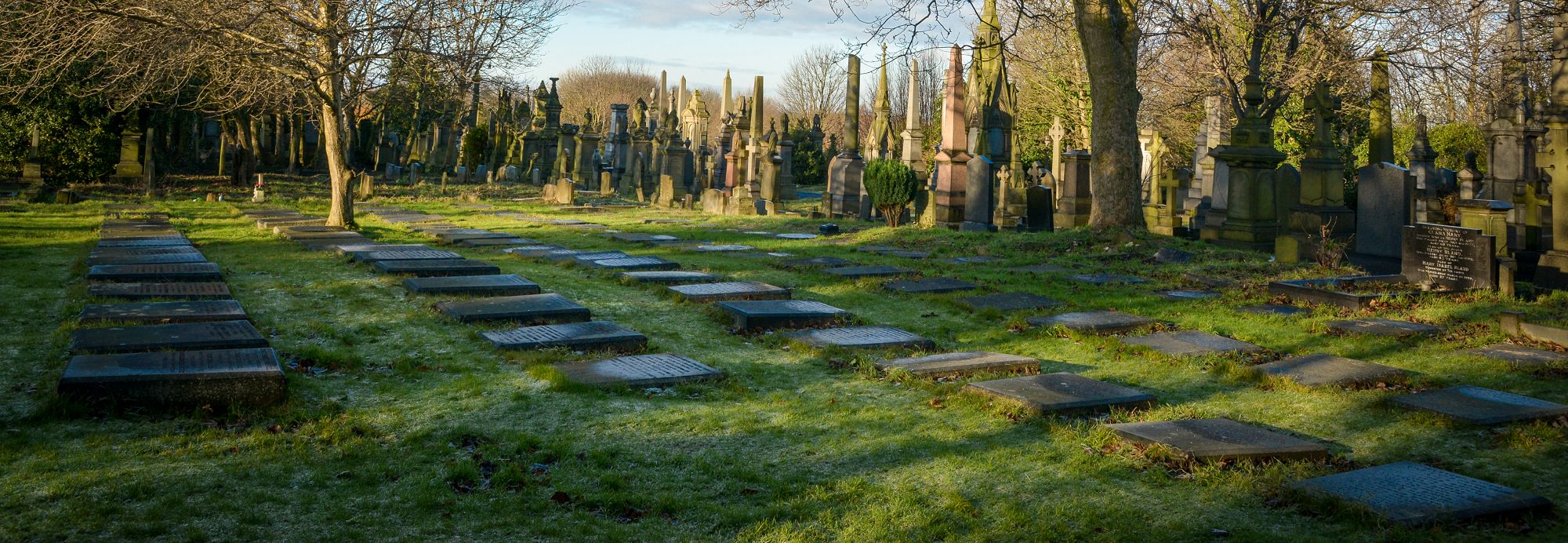Alfred Megson
Alfred Megson (1842-1895)
Alfred Megson was an unlikely candidate to become an artist and fine art dealer. He was the son of a gardener who in 1851, was also the Lodge keeper at Cottingley, Bingley. His father Robert was from Stanley, Wakefield and he married Mary Shillito in Rossington in 1837.

Alfred was Robert and Mary’s third child, second son. The eldest son, Robert followed his father into the gardening trade. This perhaps left Alfred free from the obligation to follow in his footsteps. Clearly, he showed a talent for art as he became a student at Bradford’s School of Design. It was here in 1861, that he won a First Class Certificate, 10 shillings and a sketch pad and water colour paints. He received the prize for a water colour of wild flowers. Was the 10 shillings some recompense for not providing his parents with a regular income like his siblings? In deed the census of 1861 finds the family living in Picton Street, Manningham. Robert senior is a Master Gardener, Alfred is an artist. His younger brother is a brush maker and sister Margaret a domestic servant. Alfred’s destiny appears to be very different to that of his siblings.
In 1862 he won a prize of a weeks’ trip to the International Exhibition for his watercolour drawing of a pearl oyster shell.
On 11 May 1865, the Bradford Observer reported that Alfred Megson, one of Mr W M Arundale’s students at the Bradford School of Design had one of his pictures accepted by The Royal Academy. The picture was called “Autumn Gathering” and it is reported that he had already secured a purchaser. William Arundale was only a year older than Alfred. Originating from Rothwell, son of Robert, a pattern maker, he moved to Bradford. In 1871 he was living in Houghton Place with his wife and three sons, the eldest of which was named Alfred. He is recorded on the census as an artist. Sadly, William died in 1880.
On the 20 February 1868, the Bradford Observer announced that one of Megson’s paintings had been accepted at The Scottish Royal Academy. It was called “The Dead Robin” and came with a short, typically Victorian sentimental, poem:
Poor little victim of a wanton’s sport,
How shall thy mate her loss deplore;
Thy happy morn of life – how short!
Ah, thou wilt never warble more!
On 26 October 1870, Megson married Margaret Williamson, daughter of an Ilkley boarding house keeper at Ilkley Parish Church. By 1871, Alfred and his young wife, were living in Kensington Street, Manningham and in the census of that year, he is recorded as an Artist and Photographer Chemist. The Bradford Art Society began in 1870. Megson is mentioned in the art exhibitions of 1874 and 1875. By 1877, Megson has a shop at 85 Manningham Lane and is selling Christmas cards and presents. He is also “the sole agent of the new hand-painted photographs”.
His career continued a pace and in the census of 1881 is described as an artist and art dealer. At this time, he is living in St Jude’s Place, Manningham and able to afford a maid to assist his wife with his three daughters; Minnie Shillito, Gertrude Margaret and Mabel and his son, Alfred Williamson.
By the 1890’s he has moved his business to the Swan Arcade off Market Street, Bradford where he sells fine art and is the maker and gilder of picture frames.
Ten years later he resides on North Parade, Manningham and is described as a Fine Art dealer. He now has a further three children, Ethel M, Arnold and Laurence.
Megson produced cards of paintings of Bradford by N. S. Crichton. These were exhibited in 1891 and descriptions of the scenes published in a book, “By-gone Bradford” by Arthur North.
Some of the photographic reproductions of Crichton’s pictures are shown below:
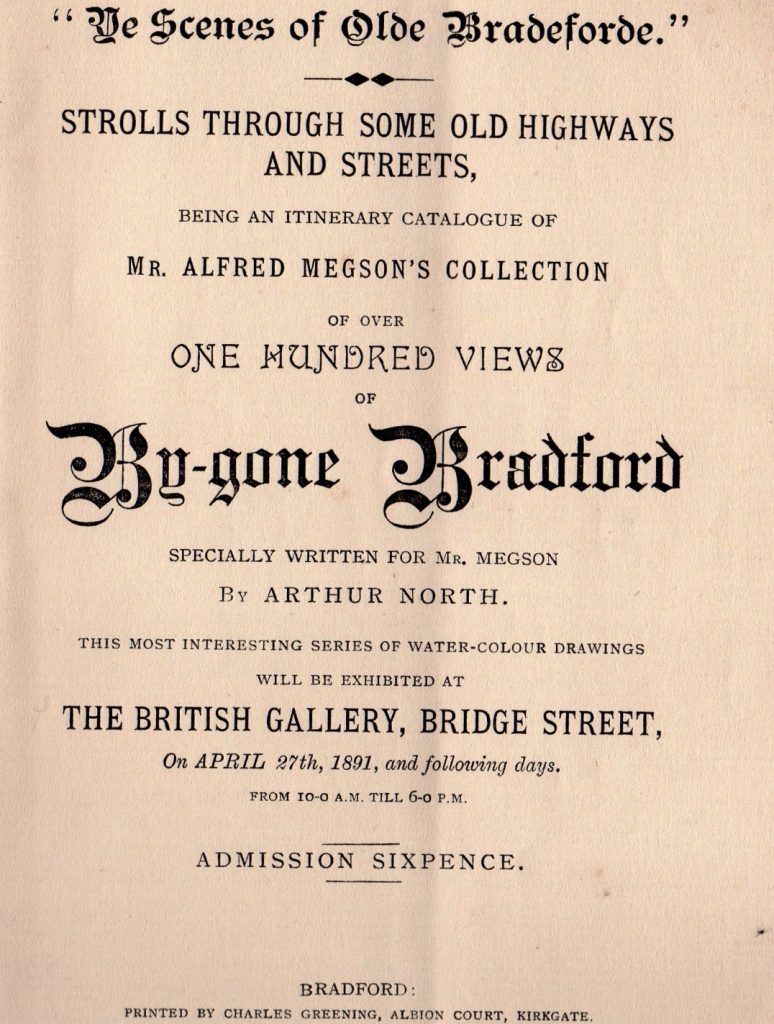
Some of the photographic reproductions of Crichton’s pictures are shown below with matching descriptions from By-Gone Bradford:
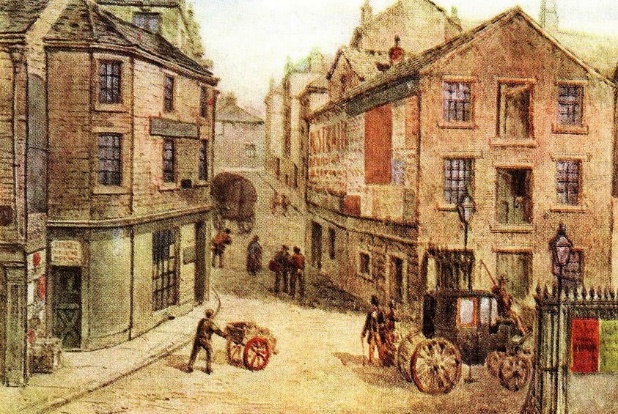
Bermondsey (At the bottom of Cheapside)
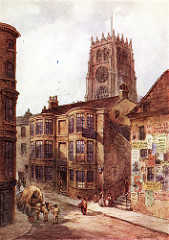
Church Steps Inn (at the bottom of what is now Bolton Road)
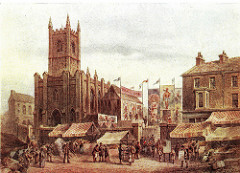
Christ Church (close to Rawson Square)
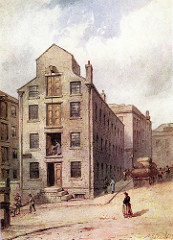
Cheapside, Bradford
Megson died on the 15 March 1895. At the time he is described as living on Oakroyd Terrace in Manningham which was at the more salubrious end of Manningham Lane. He is described as a Fine Art Dealer and an Artists colourman. He left his wife over £2,000.
Margaret, a relatively young widow with her youngest child, Laurence only aged 10, carried on the business of Fine Art Dealer with her eldest son, Alfred Williamson as her assistant. Alfred W emigrated to Canada where his fortunes were not good. When he joined up in 1916 to fight in WW1, he is recorded as being a labourer/woodsman. He is single at the time of enlisting and gives an address of Adams River Wood Co, Chase, British Columbia. He died in 1934 and buried in the Mountain View Cemetery, Vancouver. Whether he had any contact with his brother Laurence who also emigrated to Canada, is unknown.
Margaret’s second son, Arnold became her assistant as did her daughter Gertrude. Arnold later became the manager of an Antique Dealer’s shop. None of his children followed in their Grandfather’s steps by being an artist. Arnold died in Harrogate in 1945 leaving a widow, Claire Evelyn.
Laurence became a butcher and continued in this profession when he emigrated to Canada and settled in Lindsay, Victoria. In 1912 he married a Canadian, Julia Priddy. He volunteered for the armed forces in 1915 and survived the war suffering just a broken ankle and scabies.
Minnie married John Borland, a commercial traveller in 1902. He and his bride returned to his home town of Kilmarnock. Minnie died there on 16 December 1931. They had three daughters; Doris Mabel Elizabeth and Gladys.
Gertrude Margaret eventually married in 1914. Her husband was David Humphrey Barbour, a teacher who was eight years here junior. She died on 20 June 1852 in Larkhall near Glasgow.
Mabel married Robert Nixon Mather, an accountant in 1904 and they had a daughter May Gwendoline in 1905. At the time their address is listed as Crossflatts, Bingley. However, tragically, Robert died in the Transvaal, South Africa in on 26 December 1913. During 1913, South Africa was in political tumoil. The Boer war ended in 1902, however, the ruling British based government could not resolve issues between itself and the Afrikaners, or issues raised separately by the white, black and Asian working classes. There were strikes in the mines and on the railways. In the October, Ghandi led a march of striking miners and other indentured workers over the Natal Border. His eventual meeting with Smutts led to some improvements for the Indian workers. Sadly, the Native Land Act of that year restricted the ownership of land by the Native African people. The strikes of 1913 led to unrest and rioting resulting in deaths.
Although in 1904 Robert is recorded as an accountant on his marriage certificate, three years later he is recorded as being the secretary to the managing director of an iron and steel works.
During 1913 and 1914, South Africa was expanding its railway system and it is possible Robert was there in connection with the provision of materials for rails.
In 1908, Ethel Mary married Edgar Levi Humphries Langley-Smith a Pin Manufacturer from Great Horton. They lived for some time in Stroud in Gloucestershire, however, she died in Bradford in 1951 leaving Edgar a widower.
To find the grave using the what3words App follow this link and select satellite view.
Sources
Bradford Newspaper Archives
Bradford Timeline/Flickr
The census.
Research by Deborah Stirling

